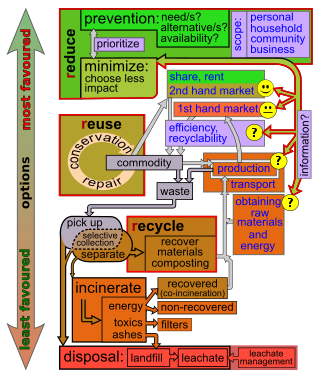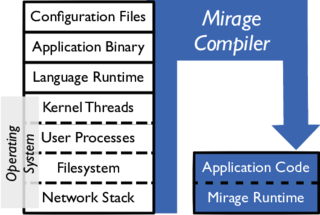
KornShell (ksh) is a Unix shell which was developed by David Korn at Bell Labs in the early 1980s and announced at USENIX on July 14, 1983. The initial development was based on Bourne shell source code. Other early contributors were Bell Labs developers Mike Veach and Pat Sullivan, who wrote the Emacs and vi-style line editing modes' code, respectively. KornShell is backward-compatible with the Bourne shell and includes many features of the C shell, inspired by the requests of Bell Labs users.

USENIX is an American 501(c)(3) nonprofit membership organization based in Berkeley, California and founded in 1975 that supports advanced computing systems, operating system (OS), and computer networking research. It organizes several conferences in these fields.
Power management is a feature of some electrical appliances, especially copiers, computers, computer CPUs, computer GPUs and computer peripherals such as monitors and printers, that turns off the power or switches the system to a low-power state when inactive. In computing this is known as PC power management and is built around a standard called ACPI which superseded APM. All recent computers have ACPI support.
Vegan organicagriculture is the organic production of food and other crops with minimal animal inputs. Vegan organic agriculture is the organic form of animal-free agriculture.

Matthew Dillon is an American software engineer known for Amiga software, contributions to FreeBSD and for starting and leading the DragonFly BSD project since 2003.

DTrace is a comprehensive dynamic tracing framework originally created by Sun Microsystems for troubleshooting kernel and application problems on production systems in real time. Originally developed for Solaris, it has since been released under the free Common Development and Distribution License (CDDL) in OpenSolaris and its descendant illumos, and has been ported to several other Unix-like systems.
Stephen Curtis Johnson is a computer scientist who worked at Bell Labs and AT&T for nearly 20 years. He is best known for Yacc, Lint, spell, and the Portable C Compiler, which contributed to the spread of Unix and C. He has also contributed to fields as diverse as computer music, psychometrics and VLSI design.
Push technology, also known as server Push, refers to a communication method, where the communication is initiated by a server rather than a client. This approach is different from the "pull" method where the communication is initiated by a client.

In a computer system or network, a runbook is a compilation of routine procedures and operations that the system administrator or operator carries out. System administrators in IT departments and NOCs use runbooks as a reference.

The business terms push and pull originated in logistics and supply chain management, but are also widely used in marketing and in the hotel distribution business.
The Agreement on Agriculture (AoA) is an international treaty of the World Trade Organization. It was negotiated during the Uruguay Round of the General Agreement on Tariffs and Trade, and entered into force with the establishment of the WTO on 1 January 1995.
An environmental management system (EMS) is "a system which integrates policy, procedures and processes for training of personnel, monitoring, summarizing, and reporting of specialized environmental performance information to internal and external stakeholders of a firm".

Waste minimisation is a set of processes and practices intended to reduce the amount of waste produced. By reducing or eliminating the generation of harmful and persistent wastes, waste minimisation supports efforts to promote a more sustainable society. Waste minimisation involves redesigning products and processes and/or changing societal patterns of consumption and production.
Joel McCormack is an American computer scientist who designed the NCR Corporation version of the p-code machine, which is a kind of stack machine popular in the 1970s as the preferred way to implement new computing architectures and languages such as Pascal and BCPL. The NCR design shares no common architecture with the Pascal MicroEngine designed by Western Digital but both were meant to execute the UCSD p-System.[1,2]

A green-collar worker is a worker who is employed in an environmental sector of the economy. Environmental green-collar workers satisfy the demand for green development. Generally, they implement environmentally conscious design, policy, and technology to improve conservation and sustainability. Formal environmental regulations as well as informal social expectations are pushing many firms to seek professionals with expertise with environmental, energy efficiency, and clean renewable energy issues. They often seek to make their output more sustainable, and thus more favorable to public opinion, governmental regulation, and the Earth's ecology.
A journaling file system is a file system that keeps track of changes not yet committed to the file system's main part by recording the goal of such changes in a data structure known as a "journal", which is usually a circular log. In the event of a system crash or power failure, such file systems can be brought back online more quickly with a lower likelihood of becoming corrupted.
Virtual memory compression is a memory management technique that utilizes data compression to reduce the size or number of paging requests to and from the auxiliary storage. In a virtual memory compression system, pages to be paged out of virtual memory are compressed and stored in physical memory, which is usually random-access memory (RAM), or sent as compressed to auxiliary storage such as a hard disk drive (HDD) or solid-state drive (SSD). In both cases the virtual memory range, whose contents has been compressed, is marked inaccessible so that attempts to access compressed pages can trigger page faults and reversal of the process. The footprint of the data being paged is reduced by the compression process; in the first instance, the freed RAM is returned to the available physical memory pool, while the compressed portion is kept in RAM. In the second instance, the compressed data is sent to auxiliary storage but the resulting I/O operation is smaller and therefore takes less time.
Dahlia Malkhi is an Israeli-American computer scientist, who works on distributed systems and cryptocurrency.

A unikernel is a type of computer program that is statically linked with the operating system code on which it depends. Unikernels are built with a specialized compiler that identifies the operating system services that a program uses and links it with one or more library operating systems that provide them. Such a program requires no separate operating system and can run instead as the guest of a hypervisor.
Site Reliability Engineering (SRE) is a discipline in the field of Software Engineering and IT infrastructure support that monitors and improves the availability and performance of deployed software systems and large software services. There is typically a focus on automation and an Infrastructure as Code methodology. SRE uses elements of software engineering, IT infrastructure, web development, and operations to assist with reliability. It is similar to DevOps as they both aim to improve the reliability and availability of deployed software systems.








